At the bottom of the hill sits our nearest neighbour: a run of whitewashed cottages which at first sight appears to be three small farm workers’ homes but is now one large and one smaller dwelling, the latter a more recent addition. These days they form the frontage of a discreet holiday business. Six pleasant wooden chalets lie beyond, out of sight of us or passers-by. The owners are warm and friendly but keep to themselves; the guests are quiet. We couldn’t ask for better neighbours.

From the neighbours we learned that the original building was once a public house and that it was also briefly the home of the writer, Mary Wesley. I read a fair few of her books in the eighties and nineties, which I then passed along to a charity shop. I rather wish I’d kept them now. She is probably best known for her second novel: The Camomile Lawn (1984) which became, as I remember it, a slightly racy tv series.
Her other claim to fame was that her first adult novel, Jumping the Queue, was published when she was aged 71. She epitomised the notion that it’s never too late to start, although she had been writing all her life and had previously written three books for children so perhaps she should be most remembered for her perseverance. Ten further novels for adults were published, the final one in 1997 when she was 84. Asked why she then stopped writing fiction, she answered: “If you haven’t got anything to say, don’t say it”. Indicative perhaps, of her acerbic tongue, and possibly advice I should heed. Mary Wesley lived a life of incident and drama, love and loneliness. She claimed that her books were not autobiographical but having read her authorised biography, it seems clear that she drew on her own experiences.
She produced a final non-fiction volume in 2001 – a celebration of her life in the West Country entitled Part of the Scenery. (Her final novel was called Part of the Furniture. I do wonder if there is a connection between these titles and her state of mind as she aged. I’m also mindful of Daphne du Maurier’s similar paeon: Enchanted Cornwall (1989). Both are described as ‘pictorial memoirs’.)


But I digress.
This was intended as an explanation of why, as I wandered the lanes through May and into June, relishing the unkempt verges, the lush growth and the ascendancy of birds and beasts, my thoughts drifting into a nostalgic reverie as a means of distraction from happenings in the wider world, I found myself thinking about Mary Wesley. What she saw, I thought to myself, when she lived here in the late 1940s, is probably very much like what I’m seeing now.


Part of the Scenery, in conjunction with Patrick Marnham’s authorised biography, Wild Mary, offers a glimpse of Mary’s experiences when she lived here. There are discrepancies between her recollections, written more than fifty years after the event, and Marnham’s account, which takes meticulous account of letters and diaries written at the time. There are also discrepancies between Mary’s opinions and mine. But here are Mary Wesley’s memories of this small corner of Cornwall, with a coy nod to Austen for the sake of privacy because the name of the house she owned has since become the name of the hamlet.
In 1947 when we bought P-, we thought, my husband and I, that we would be settled for ever in this delightful little house writing our novels and living a peaceful productive country life. We had not been able to find a house we could afford in Chagford where we had really wanted to live but P- – which had been, I believe, a country pub in the 18th century – seemed perfect.

It stood facing a lane by a bridge. There was a trout stream for a boundary, a large orchard behind the house and several good-sized fields. It seemed pretty good to us. True, there was no electricity: we bought tilley lamps and candles. We had no water except from a spring, we installed a pump and built a bathroom. The cooker was one of those black iron Victorian jobs you pay the earth for nowadays in junk shops. We put in a Rayburn.
There was no telephone and we had no car but all the tradesmen came in vans. There were some good shops in Lostwithiel and Fowey, we had strong legs and could walk and we shared a bicycle. The sea at Lansallos was within easy walking distance.


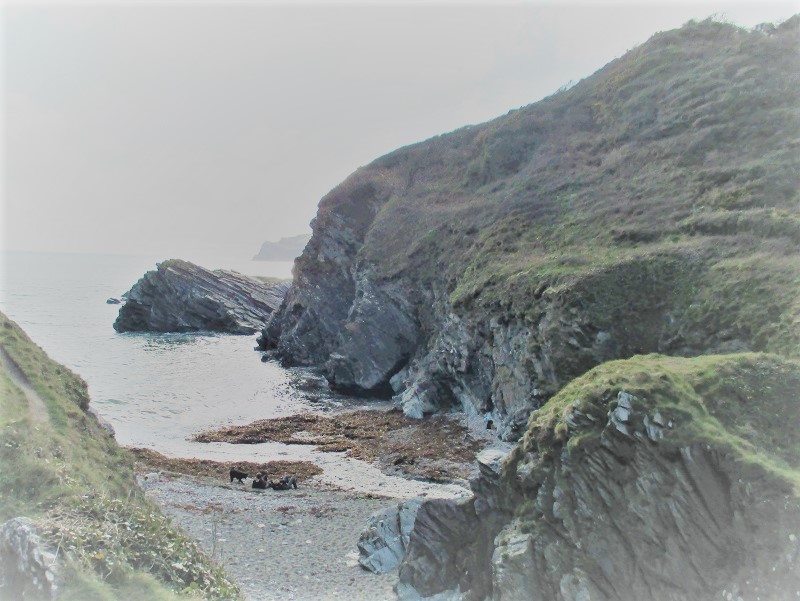
No tradesmen have regular rounds now. Just supermarket delivery vans. As the crow flies, the sea at Lansallos is indeed within easy walking distance. Sadly, the footpaths that no doubt proliferated in Mary’s tenure are now almost entirely closed off and the roads are far from direct. To walk there and back would be not far off a ten-mile round trip up hill and down dale. Not my idea of easy walking distance although the walk from what is now the National Trust car park is unchanged. It has been there for centuries – an old smugglers’ path apparently. And it is beautiful.
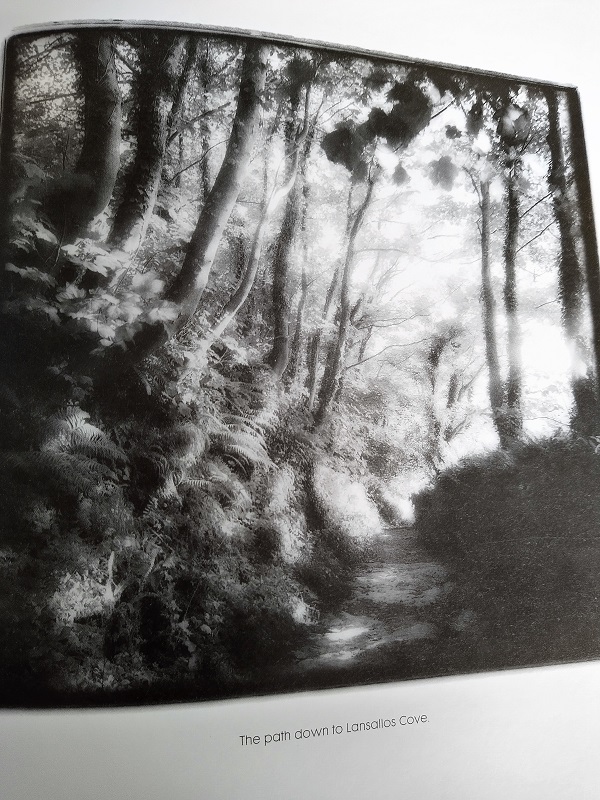
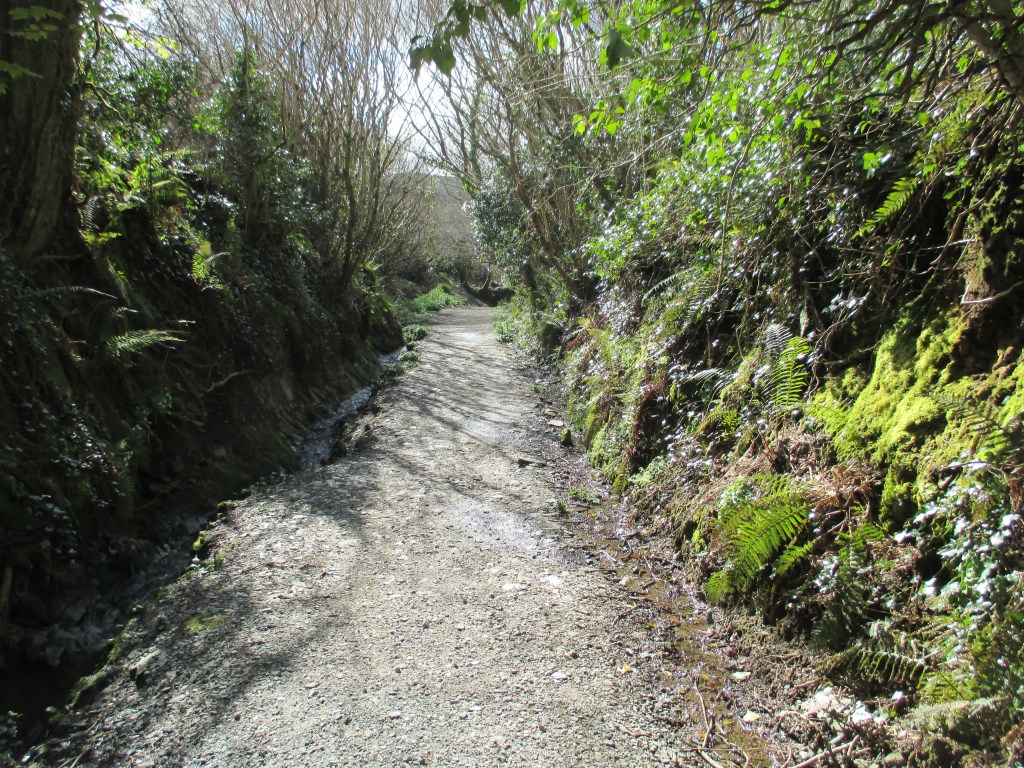
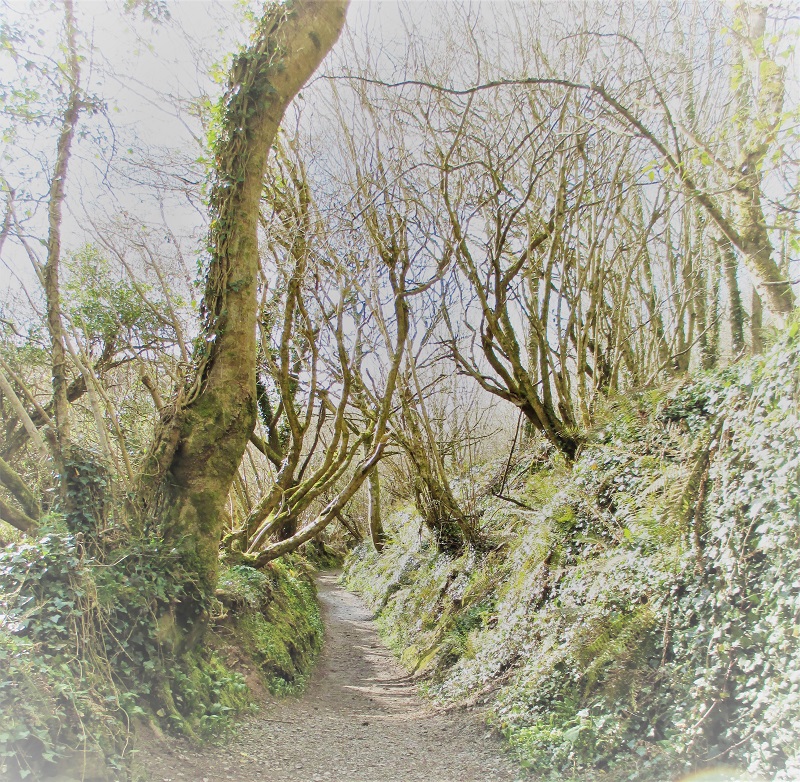
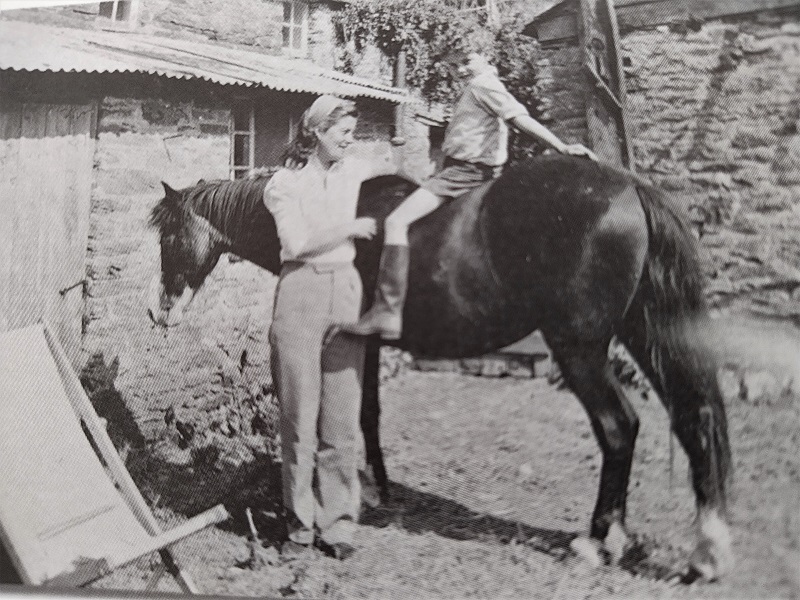
I retrieved the old pony I had had in Cornwall during the war from where he had been lodging with my sister, and a friend gave me a very old but sprightly Welsh pony who had once won the jumping at Olympia, and for good measure a large unbroken cob.
What she did not tell me was that the Welsh pony was a wanderer who jumped or barged her way out of the stoutest-hedged field, or that the cob still had one testicle and was to all intents and purposes a stallion. I spent many hours that year retrieving my horseflesh in answer to messages saying: “Your horses are in my corn” …
There are no longer wandering horses but certainly roaming dogs. We call the farm to report that we have Mollie/Bruce/Chalky in the garden, or to say we’ve just seen them miles from home. And occasionally we make the same call regarding straying cows … or sheep.
I bought two piglets. As food was still rationed, ham and sides of bacon made sense. Unfortunately before they became old enough to become ham, the pigs became friends who accompanied us for walks, answered to their names, Bentham and Hooker, and considered themselves part of the family. When eventually we ate them it was without joy. “Is this Bentham or Hooker?” a child would ask sadly, laying down his knife and fork. Still on the track of self-sufficiency, I acquired a broody hen and sat her on three goose eggs which, when they hatched, grew to be partly the originals of Gus in ‘Jumping the Queue’. …
Our predecessors here kept pigs for meat. We have no plans to continue this trend. Although I toyed briefly with buying Bernie a kune kune pig for Christmas one year. To remind him of his Kiwi roots. He seemed less than keen. Like most people, I have a hankering to keep chickens. But not geese.
All seemed set for an idyllic if fairly strenuous existence. We were happy. We woke in the mornings almost deafened by the dawn chorus. Thrush, blackbird, robin, tit and warblers – I have never heard better.

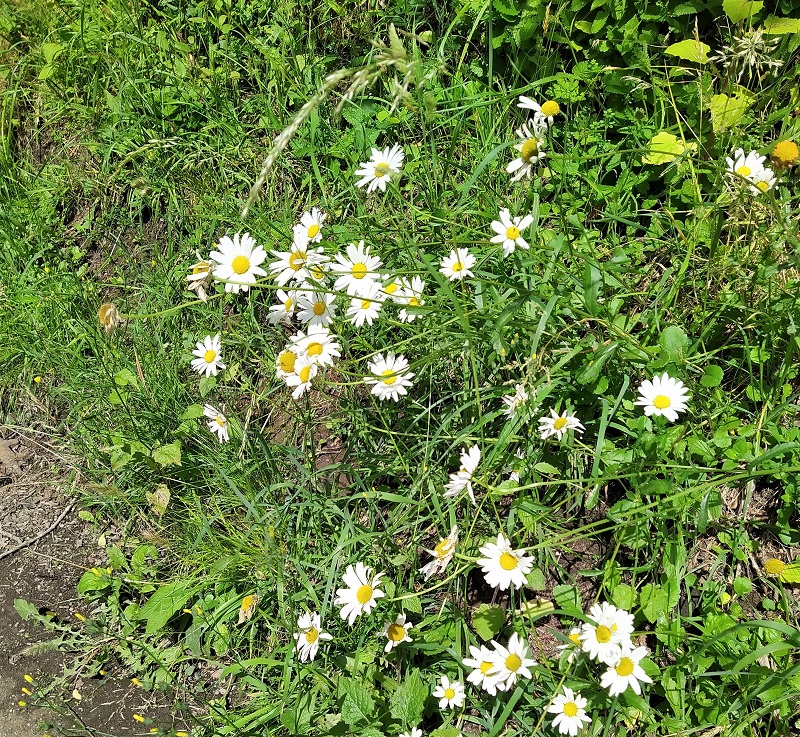


Eric worked on his novel, I tinkered with mine. We went for enormous walks inland and by the sea and watched a spring of unrivalled beauty. I have never seen such wildflowers, a mass of daffodils and primrose and later fields of orchids. The children arrived for their school holidays, rode and roamed the countryside and we all swam at Lansallos. Gradually, since no publisher had evinced interest, we ran out of money. Eric was offered a job as the Sunday Times correspondent in Berlin so off he went to Germany and soon I joined him there. From a distance we sold the house; it had been a good try.
From Patrick Marnham’s Wild Mary I can confirm that the property was purchased in spring 1948 (not 1947) and sold a year later. Mary’s husband, Eric, found the neighbours so irritating that he frequently returned to Chagford to write. It was, after all, “where they really wanted to live”. I make no comment. In August 1948 he wrote in reference to the neighbours: “I did not escape an office to be pinpricked by bumpkins”. Again, I make no comment. Although I feel duty bound to point out that there can only have been a maximum of four households within a half-mile radius and that the Cornish accent does not correlate with a lack of intelligence or sophistication.
Again, from Wild Mary, I know that by early 1949 finances compelled Eric to take another office job and he left for Berlin. Mary put the house on the market with an agent in Fowey stating in a letter to Eric: “I am only going to deal with people who know the wants of the upper classes, who are the only people likely to want this house.” I really will refrain from comment this time. It was advertised in The Times as: ‘a recently modernised 18th century house between Fowey and Polperro, 2 miles from the sea, with 5 rooms, a dairy, all modern conveniences such as a WC and hot and cold water in the bathroom and a Rayburn cooker.” It sold with a four-roomed cottage and 10 acres for £4,500.
Mary’s reminiscences continue:
Many years later a friend wanted to see P-. I had forgotten the way, had trouble finding it and when I did, I wished I hadn’t. It had become a caravan site. Caravans stood in rows where my pigs had wandered, where my ponies had grazed. The stream looked sullen and even the ghost of Gus – the goose who had never existed except in my mind – failed to show. The fields which I had seen pink with orchids had been ploughed and sprayed, and few birds sang.
And now I must add a number of comments. I can confirm that there is no caravan park here now and I would be surprised if ever there was one. The land is undulating and wouldn’t lend itself to rows of caravans. Perhaps when Mary made her return visit with her friend, she never did find her old house and was looking at a caravan park somewhere else entirely!


The stream is clear and is home to kingfishers. She must have returned on a bad day because there are always birds singing here now. The fields which belonged to her property are not ploughed and sprayed but are left wild for the enjoyment of the guests. Although I fear that one of the fields she originally described as filled with orchids is where our house now sits. Sadly there are no orchids on our land, although many can be found very close by.
But Mary and I do agree on one thing. She described her solitary spring here, seventy years ago, as “a spring of unrivalled beauty”. I’m sure she was right; I think exactly that every year. But especially so this time, this unforgettable spring of 2020, memorable for so many reasons.
As spring becomes early summer and still I walk, I think of Mary with her bicycle, her runaway horses, her pigs and Gus, the imaginary goose who found his way into her first novel some forty years later. It may take longer to get there but Lansallos Cove is still beautiful, still unspoilt. The lanes are still quiet. The neighbours are delightful. And the dog roses are in bloom.
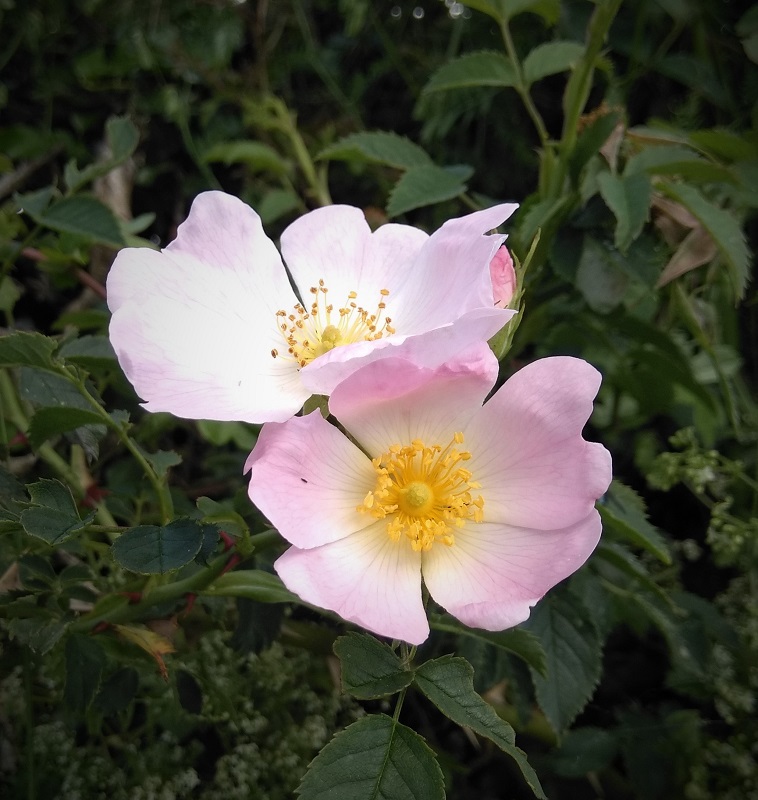
(i) I have bitten the bullet and embraced Block Editor. With help from Carol, who guided me on how to justify text. I can’t say that I like it but I accept it’s early days. I’m learning…)
(ii) This is the second attempt. Apologies to those who think they’ve seen this once already – you are right. Thanks to Margaret who alerted me to the problems. Hopefully this time around comments will be on and photographs will be visible…

What a beautiful area of the country…
LikeLiked by 1 person
It is. We are very lucky.
LikeLiked by 1 person
I love this mixture of past, present and memoir. I can’t recall if I’ve read other Mary Wesley books that Jumping the Queue (some of the covers do look familiar..) She sounds like a formidable woman! Made me think of Ruth and her goose from the Louise Penny novels that you introduced me to – I’ve read all but one in this last year.
LikeLiked by 1 person
Yes! I hadn’t thought of Ruth and her goose but you’re absolutely right, Andrea! I’m delighted that you’re enjoying the Penny novels. You’ve leap-frogged ahead of me; I’m still reading the series in order and also in the season in which each book is set. Next up for me is The Beautiful Mystery which I have planned for September. Not long to wait!
LikeLike
I started reading them when I was in the throes of anxiety and found them a comfort, so it became almost a compulsion to just carry on with the series. I’m obviously in a different place now since I started the last book weeks ago and haven’t finished it!
LikeLiked by 1 person
I shall take that as a good sign that you’re getting back to your usual self. Hopefully you will finish that book eventually and under more cheerful circumstances.
LikeLike
This is so interesting: I have vague memories of reading Mary Wesley, but it’s so nice to hear about her time in Cornwall (and her disagreement with her husband about neighbours and so forth).
LikeLiked by 1 person
I think she must have been quite formidable, Marina Sofia. I’m relieved not to have her for a neighbour!
LikeLiked by 1 person
What an interesting post and it reminded me of neighbours we once had who had donkeys who spent their lives escaping from their field to eat nearby gardens.
LikeLiked by 1 person
The grass (and all other things edible) is always greener on the other side, it seems!
LikeLike
What a fabulous post. I love the meandering text, which complements the photos and the quotes perfectly. Reading it is like strolling through your local lanes, noticing, listening, musing. By coincidence, I just yesterday purchased an audio version of The Camomile Lawn. And bravo on going with the new block editor. I can’t face it at the moment – sticking to the old way of doing things seems so much easier. I suppose I will have to go over to the dark side at some point, but not yet… 😀
LikeLiked by 1 person
I have no idea what made me switch right now, with this post, Liz. Such a long post and with so many photos – I didn’t make it easy for myself! I’m undecided whether to stick with it or switch back. At the moment I can’t see any benefits for me in using block editor. But I’ll try to give it a little more time and perhaps it will get easier.
Do please let me know what you think of The Camomile Lawn. Having spent this time immersed in Mary’s life, I am currently watching the tv series again. I remember thinking it seemed ridiculously unreal first time around but now I know that a fair bit of the goings on were drawn from her life I’m seeing it from a different perspective.
LikeLiked by 1 person
That’s so interesting about the benefits – I couldn’t see why I needed to switch either. I’m sure we will start seeing more information about it, and more bloggers trying it presumably, so time will tell. My sense is that this is a time to avoid being too much of an early-adopter!! And I will definitely feedback on TCL in due course. It will be a wee while, because I have quite a queue of audiobooks lined up (what a surprise 😂)!
LikeLiked by 1 person
Block Editor has been around for quite a while now but I don’t know many people who have talked about the switch being a positive thing for them. Probably because if is working for them there’s nothing to say; it’s those for whom it’s not working who will grumble! Having used it I’ll carry on for a while at least and see if it gets easier. It’s rather nice to think I’m ahead of the game for once!
LikeLiked by 1 person
It’ll be great to see how you get on with it – I shall watch and learn…!
LikeLiked by 1 person
Such a lovely post. I have enjoyed reading this with its mix of old and new. Truly a beautiful part of Cornwall. I must admit I have never read any of Mary Wesley books. And although I have played with the block editor, for as long as I can I shall be staying with the classic one, so much quicker to use I think.
LikeLiked by 2 people
I wish I knew what prompted me to try it out with this post, Jude. And having done so, I can’t say I like it. I can see no benefits to it although certain things, such as uploading photos, seem very much quicker. Hopefully I’ve remembered where to find the option to revert to classic editor if I decide that enough’s enough! Meanwhile, glad you enjoyed the post 😊
LikeLike
Like you, I read Mary Wesley in the 1990s … and haven’t given her a thought since, though I enjoyed her books at the time. This is a particularly lovely post though, using her as a catalyst for reflections on the area you call home. I’m so glad that I can now see this post properly – but you’ve reinforced my worries about Block Editor, and I’ll abandon thoughts of tackling it head on until some rotten day in November when nobody wants to be out of doors!
LikeLiked by 1 person
I didn’t give her a thought either until arriving here. But I’m always fascinated by the contexts around books and writers’ lives: what led to a particular book being written etc.
And thank you again for letting me know of the problems. I’m glad you enjoyed the post and especially glad that you got to see it properly! I can’t endorse Block Editor yet and I certainly can’t see any major benefits from swapping over but I don’t want to scare you off. The comments issue stemmed from trying to turn off comments in the previous post. The photograph issue I am guessing at: I played with this post on another, private, blog and then copied it over. I felt very smug about that! But I think that’s why the photos didn’t show. Second time around I constructed it here from scratch. We live and learn …
LikeLiked by 1 person
You’re not encouraging me to be adventurous… at all. I love the way you have Cornwall very much as a context for a lot of your reading. I’ll have to think about that for Yorkshire too.
LikeLiked by 1 person
You need no encouragement from me to be adventurous!
Yes, Cornwall has become a powerful cornerstone for a fair amount of my reading though not all, thankfully. I never felt this urge when living in Kent, Sussex, Oxon… Think I connect with the spirit of place here more than anywhere else I have lived. Yorkshire would most definitely work for me though. So if you do uncover any Yorkshire gems please pass them on!
LikeLiked by 1 person
Will do. The adventurous of which I speak is battling with Block Editor … 😦
LikeLiked by 1 person
Yes, I assumed that. But I see you as properly adventurous – travelling here there and everywhere. (Ok, not so much right now 😉) Me, I just sat at the laptop and tinkered for a bit… No comparison! Besides, one is adventurous surely, in order to reap the rewards gained from new experiences? Thus far, I can think of no worthwhile rewards which merit adventuring on Block Editor! 😂
LikeLiked by 1 person
Exactly. I think techies see it as an adventure. Us? Not so much.
LikeLiked by 1 person
What a beautiful post, Sandra. I’m going to look out for Mary Wesley’s books, even though she sounded snobby. She didn’t seem to realise how lucky she was to live in such a beautiful area, either. I wonder what they made of Berlin?
Your photos and stories of past and present were a joy to read, thank you 😀
LikeLiked by 1 person
Thank you, Rose 😊 Yes, she was quite a formidable character I think. I’m glad not to have her for a neighbour! 😆 Her biography is full of detail but I read it some while back and the period in Berlin escapes me. To be there so soon after the end of the war must have been quite an experience.
LikeLiked by 1 person
Oh that is a funny thought. You might have turned up in her writing in an unflattering manner!
Yes, it must have been an extraordinary time to be in the UK or Berlin. Or anywhere in Europe really.
LikeLiked by 1 person
Ha ha! Now I’m filled with the notion of how she would have described me! 😂 I’m sure I would make a fascinating book character! 😨🤦♀️😂
LikeLiked by 1 person
😀😂😇
LikeLiked by 1 person
That’s so beautiful Sandra- beautiful thoughts and prose and perfectly illustrated . Very ” Enchanted Cornwall”- and I can’t give you higher praise than that. I love the timelessness of it- past and present fused, and who’s to say where one ends and the other begins. Time is an endlessly fascinating concept.
I have only read ” Camomile Lawn” from the books you mention ( didn’t we all at the time of the TV series!) but will certainly put , at least, ” Part of the Scenery” on my sooner- rather -than -later list.xxx
LikeLiked by 1 person
Having been immersed in this post, Pat, I’m now re-watching The Camomile Lawn. Every bit as racy as I remember it and very well made. Stellar cast! Part of the Scenery is nowhere near the level of Enchanted Cornwall in my opinion. And covers a wider area. I picked up a signed copy for £3 which I’m delighted with. One day – when we get to meet again – I shall lend you my book. (It would cost more than the book itself to post it!) xx
LikeLike
I found a copy of Part of the Scenery for just over £3 postage free -soon to be mine. I’ll fit it into my burgeoning reading schedule and let you know my thoughts in my next ( long overdue) email! xxx
LikeLiked by 1 person
Fantastic! I shall look forward to it. And I’m fairly certain it’s me who’s holding up the emails! As usual! You might be interested in this article, Pat. It certainly got me thinking more about The Camomile Lawn. xx
https://www.theguardian.com/books/2006/jun/03/featuresreviews.guardianreview2
LikeLike
Thanks Sandra- I’ll follow that up tomorrow.xxx
LikeLiked by 1 person
That was an excellent article Sandra, thank you. Ian is away in Italy next week so I shall watch the DVDs with renewed interest.
Part of the Scenery- a snip at just over £3-has been delivered. What a beautiful book to look at, so reminiscent of Vanishing Cornwall ( I wonder where the idea came from???…..). I haven’t delved into the prose as yet, because my book s – to- read pile is dangerously high, but I don’t expect DDM to be toppled from her pedestal!
Email will come eventually. xxx
LikeLiked by 1 person
I’m glad you found it interesting, Pat; it does put a new slant on the books and on the period in history. I watched the series again ahving written this piece and thoroughly enjoyed it. More so than first time around. I hope you enjoy it too.
Your expectations of Part of the Scenary are spot on. At £3, it is a beautiful bargain but too self-focused to compete with DDM’s equivalent. And yes, the whole concept so clearly derived from DDM’s success with Vanishing (and Enchanted) Cornwall.
xxx
LikeLike
Somehow, I’ve never heard of Mary Wesley, but I see from a comment above that Camamile Lawn is available as an audiobook, so I may take a step into the unknown and give it a try.
LikeLiked by 1 person
She was quite well-known while her books were coming out, Alyson, but faded quickly after that I think. That said, her books were re-issued and this article is well worth a read of you are considering trying the Camomile Lawn.
https://www.theguardian.com/books/2006/jun/03/featuresreviews.guardianreview2
LikeLike
So fascinating, Sandra, that I hope you will find many more writers who trod your lanes.
LikeLiked by 1 person
I have plenty of fascinating Cornish authors to explore, Derrick, though none that lived quite to close to us now! Glad you enjoyed it 🙂
LikeLiked by 1 person
I enjoyed this post so much! I had never heard of Mary Wesley. Her writing is very good, but her husband sounds as though he was a real pain. I like your gentle yet firm opposing point of view. I checked to see if her books were available through our online library service. They aren’t.
LikeLiked by 1 person
She was well known in the UK, Laurie but I don’t know if her reputation extended across to the USA. She was quite a formidable lady from what I’ve read and I agree – her husband sounds a ghastly man! As I recall he never had a novel published despite his best efforts but he was quite respected as a journalist. I’m glad they are not our neighbours now!
LikeLiked by 1 person
A lovely series of posts, Sandra, which I’m enjoying very much. I was born in 1950 in a similar 18th century (reputedly) Coaching Inn, in North Somerset – so brings back fond memories
LikeLiked by 1 person
I’m so glad you’ve enjoyed these posts, Clive. I think this one is probably going to be the last of the series but who knows!
LikeLiked by 1 person
Wow, this is proper writing! I love how Mary Wesley inspired you to write this post. It’s nice to read local authors, one of the things I enjoy about Dickens is he often writes about places where I regularly walk.
LikeLiked by 1 person
Thanks, Stargazer 😊 Since arriving in Cornwall I’ve become a little obsessed with local authors. My Dickens reading has suffered during the Covid crisis. I had been reading him almost every day – just a chapter or two. And I’m part way through Dombey & Son. But my Dickens mojo must be stalking those London streets without me – it’s certainly not here at the moment!
LikeLiked by 1 person
I’ve thought about these posts in this series a lot lately, and found myself wishing that I was using my time more productively by getting out and exploring my surroundings more creatively. You write so beautifully about your surroundings, Sandra. And this was a fascinating insight into Mary Wesley. I want to re-read Jumping the Queue now, but it went off to the charity shop not too long ago!
LikeLiked by 1 person
Thank you, Jan 😊 I feel so lucky to be living here and I do find it inspiring in many ways. My Wesleys went to the charity shop too, as I mentioned, but I never read Jumping the Queue so I’ve picked up a cheap copy and hope to get to it soon. I’ve also been watching The Camomile Lawn again which makes me want to read that one again, and in the course of writing this post I discovered that her biographer published another book after Wild Mary – of the letters between Mary and her husband. So that’s been another cheap acquisition! I sometimes wish it wasn’t so easy to pick up these older books for a song – I have no idea how to find time to read them all!
LikeLike
I’m too old to bite the bullet with the block editor, and won’t do it until they force me to completely. In the meanwhile, I just copy old posts to make my new ones using the old editor! HA!
LikeLiked by 1 person
Clever! I know I can switch back if this new-fangled version starts to really annoy me. But I’ll give it go now I’ve taken the plunge!
LikeLiked by 1 person
Beautiful your arty effort.
LikeLiked by 1 person
Thank you, Maria. There are so many things to play with – photographs can be made to look entirely different and just occasionally it works! Hope you’re keeping well in these challenging times 😊
LikeLiked by 1 person
You are lucky to live somewhere so beautiful and unspoiled! Sadly Glasgow is encroaching on my little town and its character is becoming less distinct each year. But I still have a view of the Campsie hills from my bedroom window – so long as I remian supple enough to hang out and lean to the left… 😉
LikeLiked by 1 person
I sympathise! When still in the south-east I watched as two towns, once 6 miles apart, blended together through acres of housing estates. And the view from my flat of the distant South Downs was obliterated by… more housing estates. Every time I go back there is more building. I scarcely recognise the place now. I learned as a child that I need an open view at the back of wherever I live if I’m to flourish so your hills would be enough for me. Ironically, we have no view at the back of this house – it’s built into the side of a hill! But there are compensations … 😂
LikeLiked by 1 person
I so enjoyed reading your lovely blog post with all its beautiful imagery and language.
As someone who had people in my family from Cornwall, this gave me an insight into life there. I loved the path down to the cove and the descriptions of the animals, a well as your objectiveness.
LikeLiked by 1 person
Thank you so much! 😊 Cornwall is a fascinating place with a wide variety of terrains and its own unique cultural identity. I am aware that I tend to romanticise it, something a native-born Cornishwoman would not do: it has always been a challenging place to live and work and continues to be so for many, despite all its advantages. So I’m particularly pleased that you saw objectiveness alongside the bucolic.
And thank you for the encouragement re Block Editor! That was very much needed. I shall persevere!
LikeLike
Give yourself a few weeks with the editor. The tutorials are really helpful if you get stuck. These days I cannot remember how to use the classic editor when I am reviewing old drafts made with it.
LikeLiked by 1 person
And don’t give up on the block editor. It is excellent once you get used to it.
LikeLiked by 1 person
This reminds me so much of a series of nonfiction books about the Yorkshire Dales, by Ella Pontefract and Marie Hartley, dating from the 1930s and 1940s. Those women must have hiked thousands of miles, to know each of those dales (Wharfedale, Swaledale, Arkengarthdale, Wensleydale) so well. I don’t see Mary Wesley’s books available at my library, but I’ll keep my eyes open for them. She sounds like a writer I’d enjoy.
LikeLiked by 1 person
Those two ladies also sound similar to Mary Wesley herself – redoubtable, indefatigable…. She was very popular in the 90s, certainly in the UK. I’m not sure what sort of international reach she acquired. But you may stumble across one of her books when you’re not looking, Lizzie!
LikeLiked by 1 person
I really enjoyed the way you weaved the different strands in this post – it is really lovely and the going back and forth in time and through Mary Wesley’s writing and your own observations is so interesting and it must be hard not to make Cornwall sound bucolic! Your photos are gorgeous. I had not heard of Mary Wesley before and so I read a bit more about her and she evidently was quite something – formidable as you say.
I am happy using the Block editor and I adapted quite easily, the tutorials helped a lot. I agree it is quicker for inserting photos and I think it is quicker generally. (I compose my posts in Word and then copy into the Block editor.) I wish it had a ‘format painter’ facility for non-standard paragraphs with the same formatting and characteristics but as far as I can figure it doesn’t, so each paragraph has to be formatted individually. Some Blocks look tempting to try if and when needed such as tables. Thanks to you I have started justifying the text in paragraphs. I like how it looks on a bigger screen such as a laptop, but I find that the spacing can be odd on a smaller device such as a phone, so I might rethink that …
LikeLiked by 1 person
Thanks, Carol, I’m glad you enjoyed this one. I do struggle with trying not to romanticise Cornwall – something that Cornishmen and women rightly disapprove of. I don’t claim to succeed, but I try at least occasionally to find a balance.
You’re the second person to mention the tutorials for Block Editor – which I never bothered to look at! I like things to be intuitive these days so it’s often trial and error. That said, I have looked up a couple of things (such as how to insert the ‘read more’ tag) and easily found instructions. I shall look properly at the tutorials when time allows. I too, compose in Word and have found the copying per paragraph rather than in entirity to be faster. And uploading photos is much faster. I had a few niggly problems this time because new paragraphs wouldn’t start where I wanted them (I was using the mixed text/media blocks) but I’ll get there. Your comment about justifying on other options than laptop/desktop is helpful. I confess that I never look at how a post might appear on smaller devices. Something to think about!
LikeLiked by 1 person
Well its good to try to find a balance, but there is no denying much of Cornwall is very beautiful – at least when the weather is kind.
The tutorials on the Block Editor I looked at were quick and basic – I didn’t watch any videos though, just read some text-based ones, but perhaps I should make the time to watch some of the videos and perhaps pick up on things I would otherwise not be aware of.
I am a bit worried that I might get carried away and even consider trying out a new theme!
LikeLiked by 1 person
It is indeed very beautiful, but alongside that comes a struggling economy (especially now), housing issues, unemployment and the loss of many young people to other areas. And there is of course, the rain! I was shocked when I learned that Cornwall is one of the poorest counties in the country. (Setting aside whether it should rightly be called a county at all. It is a ‘Duchy’.)
As for changing themes – I daren’t even think about that one!
LikeLiked by 1 person
That is shocking that Cornwall is so poor relatively and I suppose tourism is (was) a mainstay of the local economy.
LikeLiked by 1 person
Tourism and fishing – another industry which has been struggling for decades and has been decimated by covid. The weather this winter kept fishermen at home for weeks, to be followed by the lockdown and closure of hospitality outlets – the primary purchasers of the Cornish catch. Visitors are pouring into the county now and no doubt the fisherman are back out at sea. All positive signs, economically 😊
LikeLiked by 1 person
I hope the late summer brings some comfort and revenue to Cornwall during these challenging times.
LikeLiked by 1 person
What a fascinating post. I’ve vague memories of reading The Camomile Lawn, many years ago, but I don’t think I found her to be an author I was tempted to follow, and I’m not drawn to the person who peeps out of your extracts, either. I envy both of you the location, though. It does indeed, look beautiful.
LikeLiked by 1 person
Indeeed, Cath. I’m not sure I would like her had I met her. But she was certainly interesting!
LikeLiked by 1 person
Yes, she made a fascinating blog post.
LikeLiked by 1 person
😆
LikeLiked by 1 person